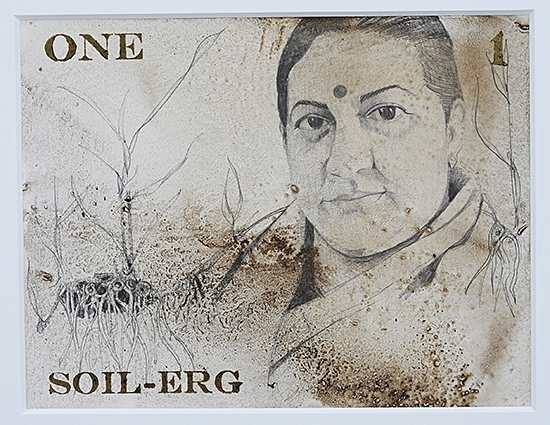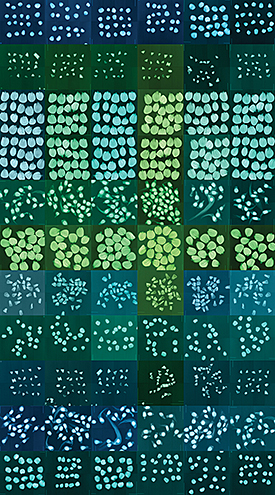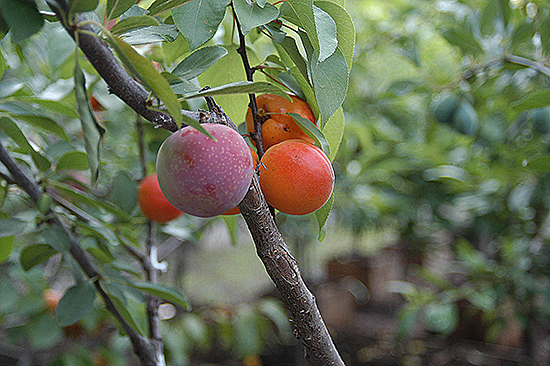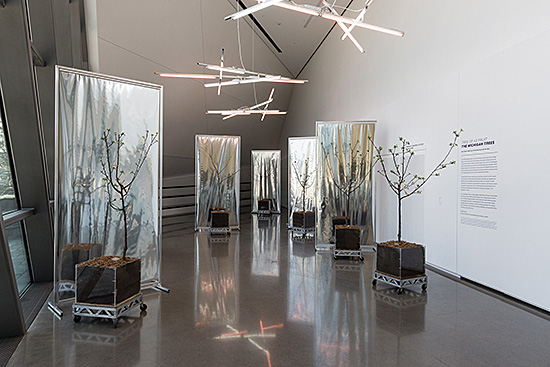June 1, 2016
Seeds of Resistance. Critical Approaches to the Corporatization of Soil, Seeds, and Stone Fruit.
Written by Steven L. Bridges
In recent decades, the corporatization of global food production has grown exponentially, the wide-ranging effects of which only further strengthen the neoliberal, capitalist policies that laid the groundwork for such developments in the first place. This “growth” is marked by the increased industrialization and privatization of agricultural production, while simultaneously consolidating power in the hands of only a handful of transnational corporations.[1] From the land, to the seeds and plants they grow, corporations—through the manipulation of capitalist-driven market economies and the influence of political interest groups—have restricted access to food production and security, all the while fueling the decline of biodiversity, natural ecological systems, and the very use-value of the “products” that are required in such systems.
It is now well-established in our contemporary societies that the development and reliance on monocultures in industrialized agricultural production diminishes the quality of the soil, the nutrients of the food, and opens the door for catastrophe through the creation of super pests (both plant and insect) and new forms of infection.[2] In their often ill-fated attempts to address these issues, the measures taken by corporations tend to exasperate the problems rather than alleviate them. The result: corporations now seek exclusive control to the rights to the entire life cycle and reproductive system of plants, livestock, and other living matter—with serious consequences for both humanity at large and the health of the planet.
Neoliberalism, Privatization, and Industrial Agriculture
To better understand the current epoch in which we live, one must first come to terms with the historical conditions that led us here. In a recent column for the Guardian, environmental and political activist George Monbiot calls attention to the slippery evasiveness of neoliberalism, an ideology “[s]o pervasive… that we seldom even recognize it as an ideology. We appear to accept the proposition that this utopian, millenarian faith describes a neutral force; a kind of biological law, like Darwin’s theory of evolution. But the philosophy arose as a conscious attempt to reshape human life and shift the locus of power.”[3] All of this has come to fruition, though perhaps not exactly according to the utopian ideals of its early enthusiasts. Further, as Monbiot goes on to describe, the more pervasive and all-encompassing neoliberalism is, the more veiled are its identifying markers. But still its basic tenets remain clear: competition defines the underlying nature of human relations, and power and authority are established through one’s capacity to buy and sell.
Touting the freedom and liberation of the individual, neoliberalism has instead created the greatest economic disparities in modern times. Part and parcel with this is the rise of neo-feudalism. A recent study conducted by researchers from Princeton and Northwestern Universities determined that the current American political system is essentially consistent with an oligarchical model of governance, composed of an elite group of individuals tied to economic and, specifically, corporate interests.[4] In our emergent neo-feudalist societies, the specters of past forms of feudalism return: greater class stratification, unequal rights for different sets of citizens, and an economic system based on servitude to an elite (or “noble”) class. The role of agriculture within this is also frighteningly reminiscent of past feudalistic systems. With the concentration of power and control noted previously, the freedom of the world’s farmers has been significantly reduced, and often farmers are coerced into relationships with larger corporate entities in an attempt to hold on to their personal livelihoods.[5]
Self-proclaimed “organic intellectual,” feminist and activist Vandana Shiva pulls no punches when she declares: “What we are seeing is the emergence of food totalitarianism, in which a handful of corporations control the entire food chain and destroy alternatives so that people do not have access to diverse, safe foods produced ecologically. Local markets are being deliberately destroyed to establish monopolies over seed and food systems.”[6] In confronting this situation, it is easy to feel immediately overwhelmed and powerless. Backed by US patent laws, biased trade agreements designed to privilege transnational corporate interests, and the heavy hand of the World Trade Organization, what agency do engaged citizens have left to counteract the seemingly unchecked powers of transnational agribusiness corporations?
The Role of Artists
In fact, there are many counter movements to the corporate takeovers that underline our age of industrial agriculture. Within the scope of this article, I would like to highlight the work of three contemporary artists who have trained their critical faculties on a number of these very issues. For it is often the role of artists to not simply hold a mirror to society in the hopes that we may recognize our own reflection, but also to refract our image in the hopes of introducing new spectrums of understanding and awareness. Especially when the macrocosmic perspective feels too unwieldy, too ungraspable and abstract, the refocusing of our attention on the microcosmic, the local, the tactical potentialities of our individual and collective efforts is all the more significant.
Collectively, the three artists to be discussed embark on projects that undermine the negative impact of neoliberal, capitalist efforts towards ever-greater social, political, and cultural homogeneity. The work of Claire Pentecost (American, b. 1956), Dornith Doherty (American, b. 1957), and Sam Van Aken (American, b. 1972) form the crux of this article; their projects pointing to the possibilities for resistance that exist and the incredible capacity and ingenuity that individuals possess to enact change. Each artist works in different media, from mixed-media installations (Pentecost), photography (Doherty), to horticulture-as-sculpture (Van Aken), and when taken altogether, the three projects to be discussed cover the life-cycle of plant life, beginning with soil, seeds, and the flora they produce.
Claire Pentecost
For her contribution to dOCUMENTA XIII, Chicago-based artist Claire Pentecost presented a multivalent project that was included in a section of the quinquennial exhibition on the study of science, ecology, and seeds. This section occupied the Ottoneum in Kassel, Germany—the city’s first theater that now operates as its museum of natural history. The contextual influences of these two incarnations of the site were not lost on the artist, who seized the opportunity to embark on a large-scale installation composed of different artworks, initiatives, and programs, accompanied by a host of actors (both evoked and in the flesh). But rather than deal with the subject of seeds directly, Pentecost focused her critical and creative energies on the seed’s cultivating environment: soil.

The resultant work, soil-erg (2012), focuses on the ways corporations have moved to monetize and commodify soil, primarily through the use of synthetic fertilizers, pesticides and herbicides to reduce the labor needed to maintain good soil, thus maximizing outputs and profits.[7] Rejecting the corporate model for the commodification of soil (and dismissal of natural ecological systems of renewal and replenishment), Pentecost created an installation that at its core offers a new system for the valuation of soil. As part of this, she fabricated bricks of living soil—in the form of gold bars and discs—along with drawings of influential activists and visionaries who have contributed to the modern environmental movement. These drawings resembled the depictions of world leaders on bank notes, yet recalculated the relationship of capital and power by highlighting individuals that have supported life and its many forms of expression.[8] The role of composting and the creation of vertical planters were other important features of the work. Installed outside the Ottoneum, Pentecost collaborated with designer Ben Friton to develop these planters to illuminate the ways that gardens can be adapted to even the most limiting of spatial constraints.

Collaboration is key too in the process of composting, wherein other species of animals—from cows to worms—play critical roles in enriching mineral depleted soils. As Vandana Shiva points out: “Returning to nature and her species their share of nutrition is not just an ethical and ecological imperative; it is essential for maintaining food productivity for humans,” and is an integral part of the responsible practice of sustainable farming that humans have practiced for millennia.[9] Furthermore, the underlying message of the project assumes an eco-activist tone, as Pentecost explains: “Good soil is alive: structurally and biologically it is a living system. When the soil is maintained in an ecologically sensitive way it not only nurtures plants, it also helps protect against weeds and pests. But it requires a continually evolving, site-specific knowledge as well as sustained labor. Good soil is the result of a sustained practice and a practice that is social as much as it is biological.”[10] The reinforcement of the social bonds that are truly at the heart of sustainable agriculture is key here. Without disruptions to the isolating effects of neoliberalism, human populations will only continue to be divided; and thus conquered.
Dornith Doherty
Dornith Doherty is a Houston-based photographer who, in 2008, was inspired by the impending completion of the Svarlbard Global Seed Vault—located on the Norwegian island of Spitsbergen in the Arctic—to begin researching, traveling to, and photographing seeds and seed banks all over the world. The result of this ongoing investigation is two significant bodies of work: Archiving Eden and Archiving Eden: The Vaults (both 2008–present). Collaborating with biologists and other scientists, the artist has visited many of the most comprehensive seed banks in the world, including: the National Center for Genetic Resources Preservation in Colorado; the Millennium Seed Bank, Royal Botanic Gardens, Kew in England; PlantBank, Threatened Flora Centre, and Kings Park Botanic Gardens in Australia; the N.I. Vavilov Institute for Plant Industry in Russia; and the Svalbard Global Seed Vault in Norway. Her interest in these spaces and activities is clear: “In this era of climate change and declining biodiversity, by collecting, researching seed biology, and storing seeds in secure vaults, seed banks play a vital role in ensuring the survival of genetic diversity in wild and agricultural species.”[11]

The two projects are deeply entwined, yet while the mechanisms of photography are consistently employed in both, the results vary according to her artistic intent. For Archiving Eden, the artist x-rays and scans thousands of seeds to create images that she composites, collages, or individuates. Some of these are then printed as lenticular images, which create an illusion of depth and allow the otherwise static nature of photography to become animated. This tension between the static and ever-changing, as well as her use of x-ray technologies, evokes intriguing metaphors for the interpretation of her project: the artist actively visualizes what is often left invisible, including the social, philosophical, political, and anthropological issues that are embedded in the very act or seed-banking, while also pointing to the need for consistent conservationist policies that are still adaptable to shifting global circumstances.

Offering a different perspective, Archiving Eden: The Vaults is inflected by the artist’s poetic sensibilities as applied to the spaces of seed banks. Ranging from the seemingly banal to the utterly sublime, these photographs by Doherty assert the great human effort that lies behind these endeavors. Documentary in nature, the images invite us to reflect upon and consider the importance of indexing history and culture through the preservation of the genetic material of plants. Rather than conducting research and experiments in the efforts of maximizing profits through the patenting of seed technologies, these seed bank and biogenetic laboratories seek to preserve the great diversity of plant life on Earth—and to create a failsafe in the event of global catastrophe.
In a sobering turn of events, and only seven years after its completion, the first withdrawal was made from the Svarlbard Global Seed Vault in 2015. The reason for such drastic measures? The civil war in Syria decimated seed supplies and one of the country’s primary seed vaults in the ancient city of Aleppo was compromised by the fighting.[12] While these events may first appear to be the unfortunate result of the conflict, recent investigations as to causal forces of the war have now identified links between the initial social upheaval and the effects of climate change on land use and food production as one of the primary driving forces.[13]
Sam Van Aken
Raised on a small family farm in rural Pennsylvania, Sam Van Aken developed an appreciation for agricultural production and the process of grafting from an early age—a fascination that continues to this day.[14] In recent years Van Aken has developed a practice that conflates horticulture and sculpture, blending horticultural techniques and aesthetic explorations in works involving living plants. In 2008, Van Aken embarked on what has become a large-scale, multi-iterative project called Tree of 40 Fruit. The premise of the project began seemingly straightforward: to seek out 40 different kinds of a species of fruit and graft them onto a single tree (familial fruit variants are often genetically compatible and thus can coexist as a single organism). However, the process of locating 40 different variants of a single species proved extremely difficult. Disturbed by the diminishing variety, the artist learned that he could source rare heirloom and antique varieties from older orchards (many of which were slated for uprooting) and collapse these collections onto a single tree. He notes: “this experience was my introduction to the extent at which monocultures have come to dominate agriculture and where the project shifted to include preservation.”[15]

For his most recent iteration, Tree of 40 Fruit: The Michigan Trees (2016), Van Aken focused his efforts on stone fruit trees that are native to the State of Michigan. Stone fruits are defined by their hard-shelled pits and include peaches, plums, apricots, nectarines, and cherries, to name a few. Once one of the largest producers of stone fruit in the US, Michigan has lost much of this agricultural legacy, as these species have been transplanted to other locales. As such, Tree of 40 Fruit: The Michigan Trees is context-responsive in the fact that its host institution—the Eli and Edythe Broad Art Museum at Michigan State University in East Lansing—is located on what was historically an orchard that included a great array of stone fruit trees. The artist again located heirloom and antique varieties, and through a series of workshops conducted with local school groups and other volunteers, Van Aken grafted the different varietals onto twelve trees that occupy an atrium of the building.
Writing in the exhibition’s brochure, Van Aken points to the sense of urgency that has emerged through the project to recover and preserve these species: “Due to numerous factors, including industrialization, disease, and decreased funding for agricultural research, over the past hundred years we have gone from having ready access to thousands upon thousands of different varieties of fruit to knowing only a few dozen. Heirloom and antique varieties of peaches, plums, apricots, nectarines, and cherries are disappearing at a frightening rate, and with them their genetic material, and in many ways our history… They are a kind of time machine, and an archive of Michigan’s agricultural heritage.”[13] Coupled with this deeper rumination on the importance of preservation and posterity, the artist also produces specific visual effects through his process of grafting; knowing which colorful blossoms will be born of each branch, he carefully selects different varietals as part of his aesthetic decision-making process. Through this blending of the political, ecological, and aesthetic, the project mines and preserves local knowledge while simultaneously activating such knowledge in order to reinstate its value and significance for generations to come.

The work of these three artists begins to sow the seeds of resistance in the face of ever-growing corporate control over global food production. Each of the projects shares an interest in acts of preservation, both of actual organic matter and agricultural processes like composting, seed-banking, and grafting. To be clear, though, these techniques have been employed by humans for millennia, and it is only more recently that such practices have become increasingly undermined through the rise of industrial agriculture and the reliance on monocultures in crop planning and production. Despite claims to the need for the industrialization of agriculture to feed a growing global population, one must consider the true costs of this shift and its effects on the livelihoods of millions of people.
In this respect, author and environmentalist Rob Nixon’s research into and articulation of “slow violence” is poignant. According to Nixon, slow violence is “a violence that occurs gradually and out of sight, a violence of delayed destruction that is dispersed across time and space, an attritional violence that is typically not viewed as violence at all.”[17] The effects of agricultural industrialization and the development of monocultures are wide-sweeping and have been shown to be both directly and indirectly detrimental to human populations. But we fail to see these effects for what they are, since they evolve slowly over time and often out of the public eye and the spectacle of the twenty-four hour news cycle. The veil of neoliberalism returns in this way, obfuscating our ability to recognize and name the problem, thus allowing such violence to continue, unchecked.
Yet through these different approaches to art-making, alternative models to the effects of neoliberal geopolitics begin to emerge. At the very least, these projects invite self-education and awareness, and rather than simply pointing out and becrying the negative effects of the corporatization of soil, seeds, and stone fruit, these artists imagine and develop new ways of relating to agriculture while caring for the planet. These projects also reorient human relations, and the relationship of humanity to its environment. As Claire Pentecost noted earlier, social networks of empowerment and resource sharing reveal alternatives to our reliance on industrial agriculture and corporate value systems that emphasize profits over personal well-being. Furthermore, through an understanding and appreciation of the work by these artists—and many others like them—we can begin to reinsert our own voices and visions for food production locally and globally, consciously resisting the erasure of the histories and cultures encoded in the genes of our seeds.
Steven L. Bridges works as Assistant Curator at the Eli and Edythe Broad Art Museum at Michigan State University. He has curated a number of exhibitions including solo exhibitions of the work of Sam Jury, Faheem Majeed, and Jason Lazarus, and also co-curated the annual Rapid Pulse International Performance Art Festival in Chicago from 2011–15. Bridges is a contributor to several journals, magazines and artist catalogues, and holds Masters’ degrees from the School of the Art Institute of Chicago.
[1] At the turn of the last century, the figures were staggering. Activist and philosopher Vandana Shiva highlights the stranglehold exerted by these corporations in her influential book Stolen Harvest: The Hijacking of the Global Food Supply: “ten corporations control 32 percent of the commercial-seed market, valued at $23 billion, and 100 percent of the market for genetically engineered, or transgenic, seeds. These corporations also control the global agrochemical and pesticide market. Just five corporations control the global trade in grain.” Vandana Shiva, Stolen Harvest: The Hijacking of the Global Food Supply (Lexington, KY: The University Press of Kentucky, 2016), 9.
[2] The link between the increased use of genetically modified organisms and herbicides and pesticides in their cultivation has been a primary focus of medical researchers in recent years. Writing in the New England Journal of Medicine, Philip J. Landrigan, M.D., and Charles Benbrook, Ph.D., raise important questions around the lack of regulatory systems in the US in the face of growing concerns around the safety and long-term effects of the use of herbicides and pesticides that are known to be carcinogenic and environmentally corrosive. The reliance on 2,4-D, a component of the Agent Orange defoliant used in the Vietnam War, is particularly troublesome. Philip J. Landrigan and Charles Benbrook, “GMOs, Herbicides, and Public Health,” New England Journal of Medicine 373, no. 8 (August 2015): 693–95.
[3] George Monbiot, “Neoliberalism—the ideology at the root of all our problems,” Guardian (London), April 15, 2016,http://www.theguardian.com/books/2016/apr/15/neoliberalism-ideology-problem-george-monbiot.
[4] Martin Gilens and Benjamin I. Page, “Testing Theories of American Politics: Elites, Interest Groups, and Average Citizens,”Perspectives on Politics 12, no. 3 (September 2014): 564–81.
[5] Global agribusiness Monsanto, for instance, requires farmers who buy their genetically modified seeds to sign their “Roundup Ready Gene Agreement,” which makes saving seeds and seed sharing criminal acts. Vandana Shiva, Stolen Harvest: The Hijacking of the Global Food Supply (Lexington, KY: The University Press of Kentucky, 2016), 92.
[6] Vandana Shiva, Stolen Harvest: The Hijacking of the Global Food Supply (Lexington, KY: The University Press of Kentucky, 2016), 17.
[7] This claim to increased productivity and the need for industrialization of agriculture to meet the world’s growing food demands has largely been debunked. It has been shown that traditional systems of polyculture are far more efficient and environmentally sound than systems of monoculture. See: Francesca Bray, “Agriculture for Developing Nations,” Scientific American (July 1994): 33–35.
[8] These figures includes such luminaries as Henry David Thoreau (1817–1862), Rachel Carson (1907–1964), Wangari Maathai (1940–2011), and Vandana Shiva (b.1952), the last of which has been particularly influential in the crafting of this essay. These drawings also included other notables, like the star-nosed mole and snails, and a reference to German artist Joseph Beuys, whose own seminal ecological project 7000 Eichen (7000 Oaks) (1982–present) was produced as part of dOCUMENTA VII.
[9] Vandana Shiva, Stolen Harvest: The Hijacking of the Global Food Supply (Lexington, KY: The University Press of Kentucky, 2016), 118.
[10] From the artist’s website: http://www.publicamateur.org/?p=85.
[11] From the artist’s website: http://dornithdoherty.com/gallery/archiving-eden/.
[12] Laura Wagner, “Syrian Civil War Prompts First Withdrawal from Doomsday Seed Vault in the Arctic,” National Public Radio, September 23, 2015, http://www.npr.org/sections/thetwo-way/2015/09/23/442858657/syrian-civil-war-prompts-first-withdrawal-from-doomsday-seed-vault-in-the-arctic.
[13] The severe drought that plagued the region between 2006 and 2009—which was intensified as a result of global warming and the effects of climate change—is one of the primary reasons many farmers gave up their land and moved to the urban centers of Syria, which subsequently led to overcrowding, food insecurity, and the social unrest that destabilized the country. Henry Fountain, “Researchers Link Syrian Conflict to a Drought Made Worse by Climate Change,” New York Times, March 2, 2015, http://www.nytimes.com/2015/03/03/science/earth/study-links-syria-conflict-to-drought-caused-by-climate-change.html?_r=0.
[14] Email correspondence with the author, May 1, 2016.
[15] Ibid
[16] Michelle Word and Sam Van Aken, Tree of 40 Fruit: The Michigan Trees (East Lansing, MI: Eli and Edythe Broad Art Museum at Michigan State University, 2016), 8.
[17] Rob NIxon, Slow Violence and the Environmentalism of the Poor (Cambridge, MA: Harvard University Press, 2011), 2.









